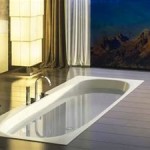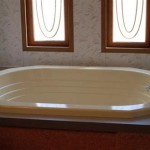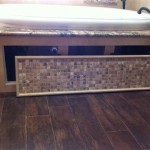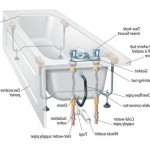```html
Handicap Walk-In Bathtubs: Enhancing Safety and Independence
Handicap walk-in bathtubs represent a significant advancement in bathroom safety and accessibility, offering individuals with mobility limitations or disabilities a safer and more comfortable bathing experience. These specialized bathtubs are designed to minimize the risk of falls and promote independent living by incorporating features that address the challenges faced by those with physical impairments. This article will explore the key features, benefits, and considerations associated with handicap walk-in bathtubs.
Key Features of Handicap Walk-In Bathtubs
The defining characteristic of a walk-in bathtub is a watertight door that allows users to enter and exit the tub without stepping over a high threshold. This eliminates the primary cause of bathroom falls – slipping while attempting to climb over the side of a standard bathtub. Beyond the low-entry threshold, a range of other features contributes to the safety and convenience of these bathing solutions.
Low-Entry Threshold and Watertight Door: The threshold of a walk-in bathtub is typically only a few inches high, making it easily accessible for individuals using wheelchairs, walkers, or those with limited leg strength and range of motion. The watertight door is engineered to create a secure seal, preventing water from leaking out once the tub is filled. These doors are generally inward-swinging or outward-swinging, and the choice often depends on the bathroom layout and the user's specific needs. The door mechanism is usually lever-operated, ensuring ease of use for those with limited dexterity.
Built-In Seating: Walk-in tubs feature a built-in seat, allowing the user to sit comfortably and securely while bathing. The height of the seat is designed to facilitate easy transfer from a wheelchair or other mobility device. The seats are typically contoured for added comfort and are often made of durable, non-slip materials.
Grab Bars: strategically placed grab bars provide additional support and stability during entry, exit, and while maneuvering within the tub. These bars are typically made of stainless steel or other corrosion-resistant materials, ensuring durability and longevity. The placement and number of grab bars can be customized to meet the individual user’s needs and preferences.
Non-Slip Surfaces: The floor and seat of a walk-in bathtub are designed with non-slip surfaces to minimize the risk of slipping and falling. Textured surfaces and specialized coatings enhance traction, providing a safer bathing environment. These features are crucial for individuals with balance issues or reduced lower body strength.
Fast Drain Systems: Walk-in bathtubs often incorporate fast drain systems to quickly empty the tub after use. This minimizes the amount of time the user must wait in the tub while the water drains, preventing discomfort and minimizing the risk of feeling chilled. Faster drain times are particularly important for individuals who are sensitive to temperature changes or who have medical conditions that require them to avoid prolonged exposure to cool temperatures.
Handheld Showerhead: A handheld showerhead provides greater flexibility and control during bathing, allowing the user to easily rinse hard-to-reach areas. This feature promotes independence and allows for a more thorough and comfortable bathing experience. The handheld showerhead is typically connected to a flexible hose and can be mounted on the wall when not in use.
Benefits of Installing a Handicap Walk-In Bathtub
The installation of a handicap walk-in bathtub offers a multitude of benefits, extending beyond mere convenience and significantly impacting the user’s quality of life and overall well-being. These benefits encompass improved safety, increased independence, therapeutic advantages, and enhanced comfort.
Enhanced Safety: The primary and most significant benefit of a walk-in bathtub is the reduced risk of falls. The low-entry threshold, grab bars, and non-slip surfaces work in concert to create a safer bathing environment, particularly for individuals with mobility limitations, balance issues, or a history of falls. This increased safety provides peace of mind for both the user and their caregivers.
Increased Independence: Walk-in bathtubs empower individuals with disabilities to maintain their independence and self-sufficiency. The ability to bathe safely and comfortably without assistance allows them to retain a sense of dignity and control over their personal care routine. This fosters a greater sense of well-being and reduces reliance on others.
Therapeutic Benefits: Many walk-in bathtubs offer therapeutic features such as hydrotherapy jets and air massage systems. These features can provide relief from muscle pain, arthritis, and other chronic conditions. The warm water and gentle massage can improve circulation, reduce inflammation, and promote relaxation. Hydrotherapy can also be beneficial for individuals recovering from injuries or surgery.
Improved Hygiene and Comfort: Walk-in bathtubs allow individuals to maintain proper hygiene and cleanliness with greater ease and comfort. The built-in seat and handheld showerhead make it easier to reach and clean all areas of the body. This can contribute to improved skin health and overall well-being. The controlled environment of the bathtub also allows for a more relaxing and enjoyable bathing experience.
Long-Term Cost Savings: While the initial investment in a walk-in bathtub may seem significant, it can lead to long-term cost savings. By reducing the risk of falls and injuries, it can help to avoid costly hospital visits and rehabilitation services. Furthermore, it can help to delay or eliminate the need for assisted living facilities, allowing individuals to remain in their own homes for longer.
Considerations When Choosing a Handicap Walk-In Bathtub
Selecting the right walk-in bathtub requires careful consideration of several factors, including the user’s specific needs, bathroom layout, budget, and installation requirements. A thorough assessment of these factors will ensure that the chosen bathtub is a good fit and provides the maximum benefit.
User Needs and Mobility: The most important consideration is the user’s individual needs and mobility limitations. Factors to consider include the user’s height, weight, range of motion, and any specific medical conditions. It is also important to consider whether the user uses a wheelchair or other mobility device, as this will affect the choice of bathtub model and its accessibility features.
Bathroom Layout and Size: The dimensions of the bathroom will determine the size and type of walk-in bathtub that can be installed. It is important to measure the available space carefully and consider the location of existing plumbing and electrical connections. Some walk-in bathtubs are designed to fit in the same space as a standard bathtub, while others require more space. The door swing direction (inward or outward) should also be considered in relation to the bathroom layout.
Budget and Features: Walk-in bathtubs vary significantly in price, depending on their size, features, and brand. It is important to establish a budget and prioritize the features that are most important to the user. Basic walk-in bathtubs offer essential safety features, while more advanced models include therapeutic features such as hydrotherapy jets and air massage systems. It's worth exploring potential funding options or grants that may be available to assist with the purchase.
Installation Requirements: Installing a walk-in bathtub typically requires professional plumbing and electrical work. It is important to choose a qualified and experienced installer who can ensure that the bathtub is installed correctly and safely. The installation process may involve modifying existing plumbing and electrical connections, as well as reinforcing the floor to support the weight of the filled bathtub. Compliance with local building codes and regulations is essential.
Door Swing Direction: Careful attention needs to be paid to whether the walk-in bathtub door swings inward or outward. An inward-swinging door may make it difficult to open the door if the person has fallen against it. An outward-swinging door needs enough clearance in the bathroom to open fully without obstruction. The optimal choice often depends on the specific layout of the bathroom and the user's potential mobility issues.
Water Heater Capacity: Filling a walk-in bathtub requires a significant amount of hot water. It is important to ensure that the home's water heater has sufficient capacity to provide the necessary hot water without depleting the supply. Upgrading to a larger water heater may be necessary to accommodate the increased demand.
By carefully considering these factors, individuals can make an informed decision and choose a handicap walk-in bathtub that meets their specific needs and provides a safe, comfortable, and enjoyable bathing experience.
```Swan Walk In Handicap Spa Bathtub Free

Handicap Walk In Bathtubs Accessible Bathroom

Walk In Tubs Bathtubs For Elderly Handicap Accessible

Barrier Free Hd2851 Walk In Tub 51 X 28 Bath

Wheelchair Transfer Bathtub 36 X55 Ellas Bubbles Walk In Tubs

Walk In Bathtub Easy Access Baths By Sync Living
Pelican Wheelchair Access Walk In Bathtub

Walk In Baths Accessible Mobility Age Co

Wheelchair Bathtubs Handicap Tub Aging Safely Baths

Pros And Cons Of Walk In Bathtubs








